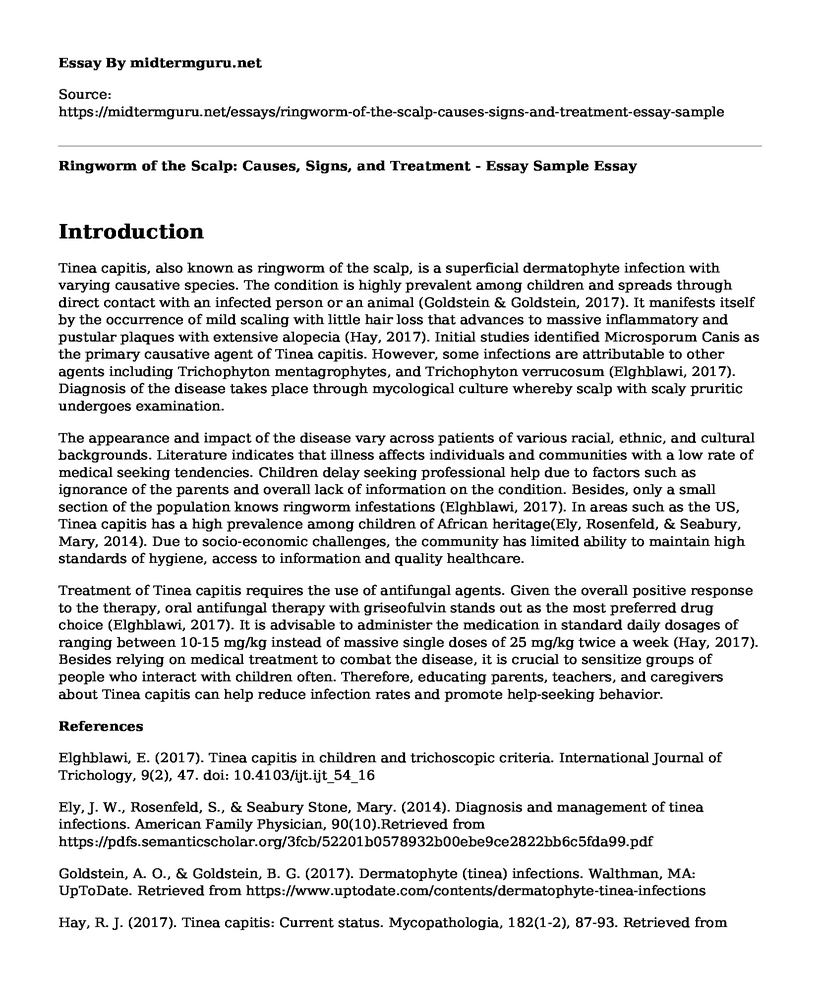Introduction
Tinea capitis, also known as ringworm of the scalp, is a superficial dermatophyte infection with varying causative species. The condition is highly prevalent among children and spreads through direct contact with an infected person or an animal (Goldstein & Goldstein, 2017). It manifests itself by the occurrence of mild scaling with little hair loss that advances to massive inflammatory and pustular plaques with extensive alopecia (Hay, 2017). Initial studies identified Microsporum Canis as the primary causative agent of Tinea capitis. However, some infections are attributable to other agents including Trichophyton mentagrophytes, and Trichophyton verrucosum (Elghblawi, 2017). Diagnosis of the disease takes place through mycological culture whereby scalp with scaly pruritic undergoes examination.
The appearance and impact of the disease vary across patients of various racial, ethnic, and cultural backgrounds. Literature indicates that illness affects individuals and communities with a low rate of medical seeking tendencies. Children delay seeking professional help due to factors such as ignorance of the parents and overall lack of information on the condition. Besides, only a small section of the population knows ringworm infestations (Elghblawi, 2017). In areas such as the US, Tinea capitis has a high prevalence among children of African heritage(Ely, Rosenfeld, & Seabury, Mary, 2014). Due to socio-economic challenges, the community has limited ability to maintain high standards of hygiene, access to information and quality healthcare.
Treatment of Tinea capitis requires the use of antifungal agents. Given the overall positive response to the therapy, oral antifungal therapy with griseofulvin stands out as the most preferred drug choice (Elghblawi, 2017). It is advisable to administer the medication in standard daily dosages of ranging between 10-15 mg/kg instead of massive single doses of 25 mg/kg twice a week (Hay, 2017). Besides relying on medical treatment to combat the disease, it is crucial to sensitize groups of people who interact with children often. Therefore, educating parents, teachers, and caregivers about Tinea capitis can help reduce infection rates and promote help-seeking behavior.
References
Elghblawi, E. (2017). Tinea capitis in children and trichoscopic criteria. International Journal of Trichology, 9(2), 47. doi: 10.4103/ijt.ijt_54_16
Ely, J. W., Rosenfeld, S., & Seabury Stone, Mary. (2014). Diagnosis and management of tinea infections. American Family Physician, 90(10).Retrieved from https://pdfs.semanticscholar.org/3fcb/52201b0578932b00ebe9ce2822bb6c5fda99.pdf
Goldstein, A. O., & Goldstein, B. G. (2017). Dermatophyte (tinea) infections. Walthman, MA: UpToDate. Retrieved from https://www.uptodate.com/contents/dermatophyte-tinea-infections
Hay, R. J. (2017). Tinea capitis: Current status. Mycopathologia, 182(1-2), 87-93. Retrieved from https://link.springer.com/article/10.1007/s11046-016-0058-8
Cite this page
Ringworm of the Scalp: Causes, Signs, and Treatment - Essay Sample. (2022, Dec 26). Retrieved from https://midtermguru.com/essays/ringworm-of-the-scalp-causes-signs-and-treatment-essay-sample
If you are the original author of this essay and no longer wish to have it published on the midtermguru.com website, please click below to request its removal:
- Animal Experimentations - Essay Sample
- The Healthcare Policy Issue: Unsafe Care for the Patient and Burnout for the Nurse - Paper Example
- Annotated Bibliography on Drug and Alcohol Addiction - Paper Example
- Paper Example on Technology-Mediated Diabetes Prevention Interventions
- 19th Century Mystery: Type 2 Diabetes - Essay Sample
- GMOs: Controversy and Benefits of a Technological Discovery - Essay Sample
- Homelessness & College Students: Exploring the Issue & Solutions - Research Paper







